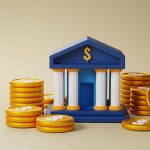Bad: stubborn prices increases. Surprisingly good these days: Your ability to outrun them.
By William Baldwin, Senior Contributor
Ugly truth about inflation: Once it gets started, it’s hard to stop. But there’s an auspicious element of what’s going on in the financial markets: Investors are much better equipped than they used to be to combat the erosion of their savings.
The 3% gain reported February 12 in consumer prices over the past 12 months came in a bit higher than expected and contrasts with the Federal Reserve’s inflation target. On February 13 the Producer Price Index, a measure of wholesale prices, reinforced the bad news with a 3.5% gain.
The price of eggs gets a lot of attention but is mostly irrelevant. This is a supply and demand problem, related to avian flu. Inflation is not intended to measure shortages, such as what you see in poultry. It is intended to measure what’s happening to a currency. Indeed, food prices are up only 2.5% over the past year.
Whatever inflation does to your breakfast menu, it does a lot of damage elsewhere by being incorporated into interest rates. Higher interest rates make payments on new mortgages less affordable. They kill bond prices.
Nothing good about that for someone who doesn’t yet own a home or who bought bonds a few years ago. But there’s now a bonanza for savers putting new capital to work: Real interest rates are high. You can get a guaranteed 2.4% return, in purchasing power, on a 30-year Treasury Inflation Protected Security. That’s up from the negative yields seen a few years ago (see chart above).
The yield on an old-fashioned U.S. Treasury bond, the kind that doesn’t have inflation protection, has three components: (a) a real yield, (b) expected inflation and (c) a risk premium. The risk premium is the extra enhancement, beyond what investors expect for inflation, needed to compensate them for bearing uncertainty about future prices. The size of the premium is debated but is probably at least 0.1%.
What do investors expect for inflation? To measure that, start by comparing the yield on unprotected T bonds (4.7% for the ones due in late 2054) to the yield on TIPS (2.4%). The difference, 2.3%, is called the breakeven rate. If inflation averages 2.3% over three decades, then the two kinds of bonds yield the same result. If it averages a higher number then the TIPS will do better.
Subtract, from the breakeven rate, something for the risk premium and you get an estimate near 2.2% for investors’ best guess for what will happen to prices over the long pull.
During the past several years of bond market turmoil that followed a monetary tightening by the Fed, breakeven rates have been fairly steady at just above 2%. The big movement, rather, has been in real rates. Real rates are a matter of supply and demand for capital, beyond the control of the Fed.
Too many users of capital, such as home buyers, builders of data centers and the deficit-happy federal government, are competing for the attention of capital suppliers. Result: If you are a supplier by dint of saving for retirement, you now get a pretty good return on a risk-free fixed-income holding.
Parallel question: What do consumers expect for inflation? They have a more pessimistic view than bond market players. A survey released this week by the New York Federal Reserve Bank puts their average expectation at 3%. The popular expectation is important for this reason: It tends to get built into wage demands and the willingness of consumers to give in to higher prices. It’s part of what gives momentum to inflation. It helps explain why inflation spiraled upward in the 1970s.
There is good reason to be fretful. The tariffs threatened by President Trump would boost prices. The deportation of workers might push up wages. Then there is the federal deficit, projected at $1.9 trillion for this year and destined to go up if Trump wins an extension of his 2017 tax cut or fulfills a promise to exempt overtime and tips from taxation.
Deficits can warp the price level in different ways. Economist Charles Calomiris sees them as motivating the government to pay its bills by extracting an “inflation tax” on the economy, via a loss in the purchasing power of currency and bank reserves. John Cochrane, at Stanford University’s Hoover Institution, sees inflation being driven by the way investors discount the future budget surpluses that would be needed to pay down ever-rising Treasury debt. Either way, politicians’ profligacy puts pressure on the consumer price level.
Despite the obvious trends, the persistence of inflation seems to leave the monitors of our money supply baffled at times. A few years ago the Fed was saying that price spikes were transitory. It eventually abandoned that unconvincing adjective, but still felt so sure last fall about its progress in tamping inflation that it loosened the money supply. Its self-confidence now seems premature.
If you think a 2.2% inflation forecast over the long term is Pollyannaish, sell some unprotected Treasuries in your IRA and buy TIPS. (Instructions: It’s Time To Buy Bonds.) You will not be insulated from regrets—TIPS yields a year from now might be still better—but you will be protected from surprises. You can lock in an ability to buy future groceries.
MORE FROM FORBES
Read the full article here




